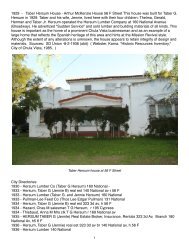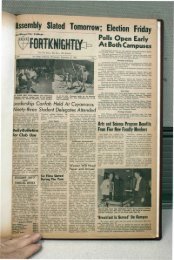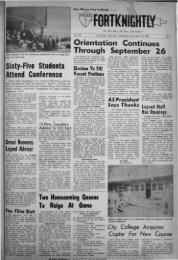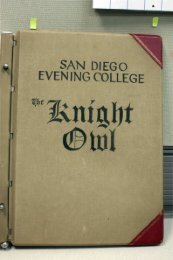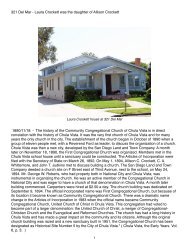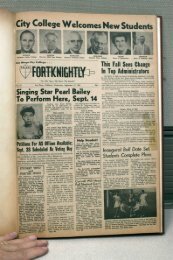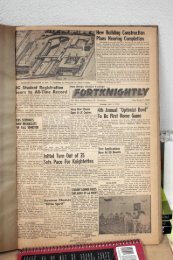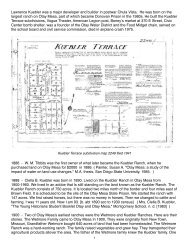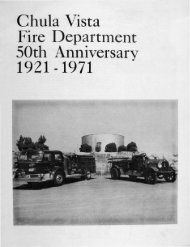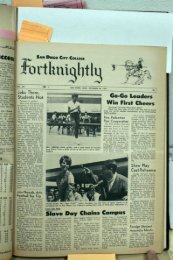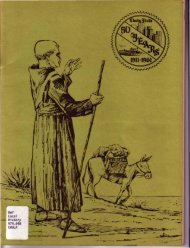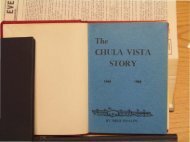doc241 - Schoenherr Home Page in Sunny Chula Vista
doc241 - Schoenherr Home Page in Sunny Chula Vista
doc241 - Schoenherr Home Page in Sunny Chula Vista
Create successful ePaper yourself
Turn your PDF publications into a flip-book with our unique Google optimized e-Paper software.
1800. Their successors were José Panella (arrived June, 1797), and José Barona (arrived<br />
May, 1798). Pedro de San José Estévan was supernumerary, April, 1796, to July,<br />
1797. Panella was accused of cruelty to the neophytes and was reprimanded by President<br />
Lasuen. He left the country <strong>in</strong> 1803. Barona rema<strong>in</strong>ed as m<strong>in</strong>ister throughout the<br />
decade (1800-1810). Panella was replaced for about a year after 1803 by Mariano Payeras,<br />
and then José Bernardo Sanchez took the place <strong>in</strong> 1804. Pedro de la Cueva, from<br />
Mission San José, was here for a short time <strong>in</strong> 1806, and José Pedro Panto came <strong>in</strong><br />
September, 1810.<br />
1810. Father Sanchez cont<strong>in</strong>ued to serve until the spr<strong>in</strong>g of 1820, when he was succeeded<br />
by Vicente Pascual Oliva. Panto died <strong>in</strong> 1812, and Fernando Mart<strong>in</strong> took his<br />
place. "Panto," says Bancroft, "was a rigorous discipl<strong>in</strong>arian and severe <strong>in</strong> his punishments.<br />
One even<strong>in</strong>g <strong>in</strong> November, 1811, his soup was poisoned, caus<strong>in</strong>g vomit<strong>in</strong>g. His<br />
cook, Nazario, was arrested and admitted hav<strong>in</strong>g put the 'yerba,' powdered cuchasquelaai,<br />
<strong>in</strong> the soup with a view to escape the Father's <strong>in</strong>tolerable flogg<strong>in</strong>gs, hav<strong>in</strong>g received<br />
<strong>in</strong> succession fifty, twenty-five, twenty-four, and twenty-five lashes <strong>in</strong> the twentyfour<br />
hours preced<strong>in</strong>g his attempted revenge. There is much reason to suppose that the<br />
friar's death on June 30th of the next year was attributable to the poison<strong>in</strong>g." The new<br />
Mission Church was dedicated November 12, 1813 (this is the build<strong>in</strong>g whose ru<strong>in</strong>s yet<br />
rema<strong>in</strong>). The bless<strong>in</strong>g was pronounced by José Barona, of San Juan. The first sermon<br />
was by Geronimo Boscana, of San Luis, the second by the Dom<strong>in</strong>ican Tomás Ahumada,<br />
of San Miguel, and Lieutenant Ruiz acted as sponsor.<br />
1820. Father Mart<strong>in</strong>ez served for a time <strong>in</strong> 1827.<br />
1830. Fathers Oliva and Mart<strong>in</strong> cont<strong>in</strong>ued <strong>in</strong> charge. Mart<strong>in</strong> died October 19, 1838. He<br />
was a native of Robledillo, Spa<strong>in</strong>, born May 26, 1770. He was a Franciscan, and arrived<br />
at San Diego July 6, 1811. He was regarded as an exemplary frey. He was one of the<br />
few missionaries who took the oath of allegiance to Mexico.<br />
1840. Oliva rema<strong>in</strong>ed alone, and was the last missionary to occupy the mission, till<br />
August, 1846. Upon the secularization of the missions <strong>in</strong> 1835, José Joaqu<strong>in</strong> Ortega<br />
was placed <strong>in</strong> charge as majordomo or adm<strong>in</strong>istrator, and 1840 he was replaced by<br />
Juan M. Osuna. Others served at different times. Some Indians l<strong>in</strong>gered at the place,<br />
and <strong>in</strong> 1848 Philip Crosthwaite leased the Mission. Oliva went first to San Luis Rey, then<br />
to San Juan Capistrano, where he died <strong>in</strong> January, 1848.<br />
<strong>Page</strong> 79<br />
PART SECOND. WHEN OLD TOWN WAS SAN DIEGO<br />
<strong>Page</strong> 81<br />
PART II. CHAPTER I. LIFE ON PRESIDIO HILL UNDER THE SPANISH FLAG.<br />
For more than a hundred years Old Town was San Diego. It began with the<br />
found<strong>in</strong>g of the fort and mission <strong>in</strong> July, 1769; it ended, as a place of real consequence,<br />
with the fire of April, 1872, which destroyed most of the bus<strong>in</strong>ess part of the town and<br />
turned the scale decisively <strong>in</strong> favor of the new settlement which had sprung up at Horton's<br />
Addition, or South San Diego, as it was then called. It is rare that two historical



